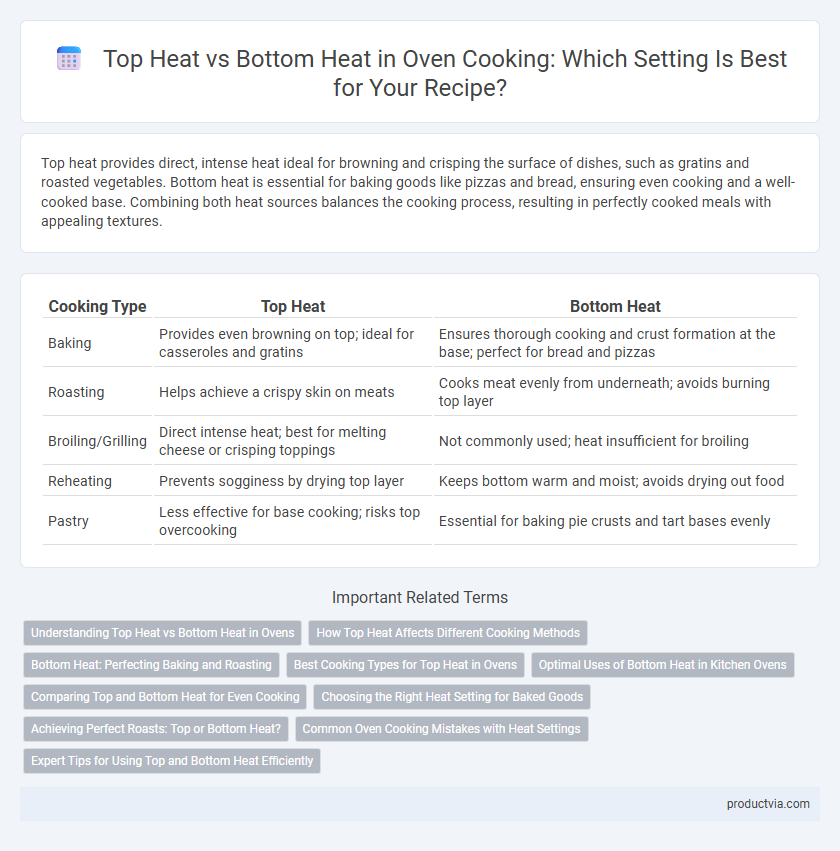Top heat provides direct, intense heat ideal for browning and crisping the surface of dishes, such as gratins and roasted vegetables. Bottom heat is essential for baking goods like pizzas and bread, ensuring even cooking and a well-cooked base. Combining both heat sources balances the cooking process, resulting in perfectly cooked meals with appealing textures.
Table of Comparison
| Cooking Type | Top Heat | Bottom Heat |
|---|---|---|
| Baking | Provides even browning on top; ideal for casseroles and gratins | Ensures thorough cooking and crust formation at the base; perfect for bread and pizzas |
| Roasting | Helps achieve a crispy skin on meats | Cooks meat evenly from underneath; avoids burning top layer |
| Broiling/Grilling | Direct intense heat; best for melting cheese or crisping toppings | Not commonly used; heat insufficient for broiling |
| Reheating | Prevents sogginess by drying top layer | Keeps bottom warm and moist; avoids drying out food |
| Pastry | Less effective for base cooking; risks top overcooking | Essential for baking pie crusts and tart bases evenly |
Understanding Top Heat vs Bottom Heat in Ovens
Top heat in ovens heats food from above, ideal for browning, grilling, or crisping surfaces like casseroles and roasted vegetables. Bottom heat provides direct heat from underneath, perfect for baking bread, pizzas, and items requiring thorough base cooking without burning the top. Understanding the specific effects of top versus bottom heat ensures precise control over cooking results and texture.
How Top Heat Affects Different Cooking Methods
Top heat in ovens delivers direct radiant heat from above, ideal for broiling and browning dishes such as casseroles or gratins by creating a crispy, caramelized surface. It excels in finishing touches like melting cheese and crisping toppings without overcooking the interior, making it essential for recipes requiring a pronounced crust. Baking items like bread or pastries, top heat can enhance crust color while maintaining moisture inside when combined with bottom heat settings.
Bottom Heat: Perfecting Baking and Roasting
Bottom heat in ovens ensures even cooking by providing direct warmth to the base of dishes, ideal for baking breads and roasting vegetables. It promotes a crispy crust and thorough cooking, essential for items like pizza and casseroles where a solid foundation texture is crucial. Optimal control of bottom heat settings enhances moisture retention and caramelization, delivering superior taste and consistent results.
Best Cooking Types for Top Heat in Ovens
Top heat in ovens is ideal for browning, broiling, and grilling, providing intense, direct heat that crisps the surface of foods such as casseroles, gratins, and roasted vegetables. This cooking method excels at creating a golden crust on baked goods like pastries and bread, while also effectively melting cheese toppings. Using top heat ensures precise finishing touches and enhances flavors through caramelization and Maillard reactions.
Optimal Uses of Bottom Heat in Kitchen Ovens
Bottom heat in kitchen ovens is essential for dishes requiring a crisp base or thorough cooking from underneath, such as pizzas, bread, and casseroles. It ensures even browning of crusts and prevents sogginess by directing heat to the lower section of the food. Optimal use of bottom heat enhances texture and flavor, making it ideal for recipes with dense or doughy components.
Comparing Top and Bottom Heat for Even Cooking
Top heat in ovens delivers direct radiant heat from the upper element, ideal for browning and crisping dishes like gratins or roasted vegetables. Bottom heat provides consistent, gentle warmth from the lower element, perfect for baking bread or pizza requiring thorough cooking without burning the base. For even cooking, many ovens combine both heats to balance crust development and internal moisture, avoiding uneven spots or undercooked centers.
Choosing the Right Heat Setting for Baked Goods
Top heat in ovens provides direct radiant heat ideal for browning and crisping the surface of baked goods like casseroles and gratins. Bottom heat ensures even cooking and thorough baking, making it essential for delicate items like bread and pastries that require consistent rising and texture. Selecting the appropriate heat source depends on the desired crust texture and internal doneness to achieve optimal baking results.
Achieving Perfect Roasts: Top or Bottom Heat?
Achieving perfect roasts requires understanding the roles of top and bottom heat in an oven; top heat (broiling) is ideal for browning and crisping the surface, while bottom heat ensures even cooking and thorough roasting. Using bottom heat helps cook the interior of large cuts evenly without burning the exterior, whereas top heat is best for finishing touches like glazing or forming a crust. Combining both heat sources strategically results in a balanced roast with a tender interior and a flavorful, golden-brown exterior.
Common Oven Cooking Mistakes with Heat Settings
Top heat in ovens is ideal for broiling and browning dishes, while bottom heat is best for baking and slow cooking. A common mistake is using top heat alone for baking, which can cause uneven cooking and burnt tops with undercooked interiors. Properly balancing top and bottom heat ensures even heat distribution, preventing common issues such as soggy bases or raw centers in baked goods.
Expert Tips for Using Top and Bottom Heat Efficiently
Top heat is ideal for browning and crisping the surface of dishes such as casseroles and gratins, providing even color and texture. Bottom heat excels in baking breads and pizzas, ensuring thorough cooking by delivering consistent heat to the base. For efficient use, experts recommend combining both heat sources for balanced cooking, adjusting oven settings based on food type and desired texture.
Top heat vs Bottom heat for cooking type Infographic

 productvia.com
productvia.com